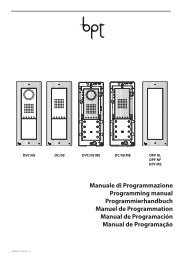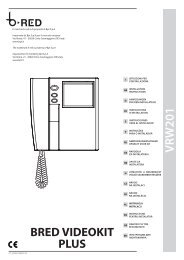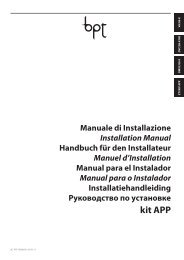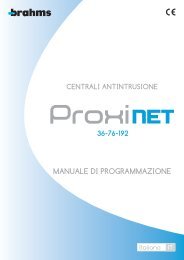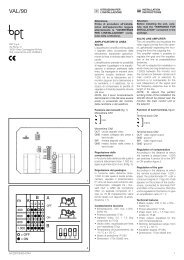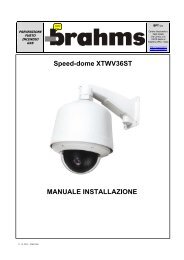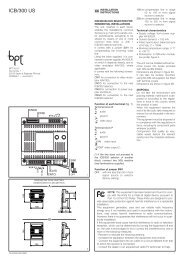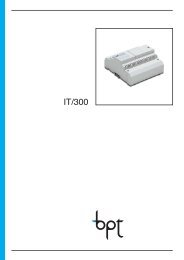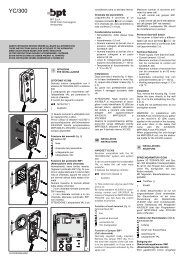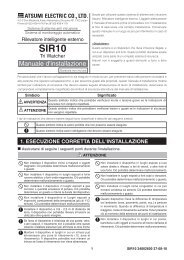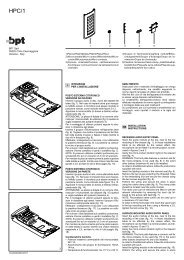XA/301LR - Bpt
XA/301LR - Bpt
XA/301LR - Bpt
Create successful ePaper yourself
Turn your PDF publications into a flip-book with our unique Google optimized e-Paper software.
1 2 3<br />
4 5 6<br />
7<br />
P<br />
8<br />
9<br />
0 C<br />
S<br />
T<br />
2 - Then press call button no. 12 (position<br />
2C) to define the total number of<br />
user calls for the block (12).<br />
Wait for the confirmation note (*).<br />
E<strong>XA</strong>MPLE 4 - Block X2-X1 with entry<br />
panel with AZ/304 or AZV/304 with 2<br />
calls without additional button panels<br />
(fig. 12).<br />
1D<br />
12<br />
1 - Press call button no. 1 (position<br />
1D) to define the number of buttons<br />
used (2) in the audio/video panel.<br />
Wait for the confirmation note (*).<br />
2 - Press the same button again to<br />
define the total number of user calls for<br />
the block (2).<br />
Wait for the confirmation note (*).<br />
E<strong>XA</strong>MPLE 5 - Block X2-X1 with entry<br />
panel with AZ/304 or AZV/304 with 10<br />
calls and additional button panels that<br />
use the module VZS/308C (fig. 13).<br />
1E<br />
2E<br />
13<br />
1 - Press call button no. 4 (position 1E)<br />
to define the number of buttons used<br />
(4) in the audio/video panel.<br />
Wait for the confirmation note (*).<br />
2 - Then press call button no. 10 (position<br />
2E) to define the total number of<br />
user calls used (10).<br />
Wait for the confirmation note (*).<br />
ATTENTION. If the system includes a<br />
porter switchboard, the first button<br />
will automatically be assigned to<br />
the porter call.<br />
E<strong>XA</strong>MPLE 6 - Block X2-X1 with Targha<br />
digital video entry panel with 20 calls<br />
(fig. 14).<br />
1-2<br />
3<br />
4 C<br />
2 0<br />
14<br />
1 - Type in 4 and (if you are using<br />
the porter call P type in 3 and ).<br />
Wait for the confirmation note (*).<br />
2 - Type in C to cancel the number<br />
shown on the display.<br />
3 - Type in 20 and to define the<br />
total number of users of the block (20).<br />
Wait for the confirmation note (*).<br />
(*) Type of confirmation note<br />
The confirmation note consists of an<br />
acoustic call signal and a double acoustic<br />
signal with activation of the solenoid lock<br />
command.<br />
2 - PROGRAMMING<br />
INTERNAL EXTENSIONS<br />
2.1 - Access internal extension programming<br />
(the yellow LED flashes<br />
steadily).<br />
2.2 - Lift the receiver of the internal<br />
extension to be programmed.<br />
If there is a hands-free internal extension,<br />
simultaneously press the two buttons<br />
and so that the audio automatically<br />
activates, going directly to point 2.4.<br />
2.3 - Simultaneously press the two buttons<br />
and of the internal extension<br />
for at least 1 s;<br />
the unit inserts with the 300 or porter<br />
(entry panel no. 1, default).<br />
2.4 - Make the call from the entry panel<br />
or IPD/300LR if set up;<br />
when programming is complete, there is an<br />
acoustic signal in the internal extension.<br />
2.5 - End communication by hanging<br />
up the microtelephone or pressing the<br />
hands-free button.<br />
2.6 - Repeat the procedure in points<br />
2.2, 2.3 and 2.4 for all internal extensions.<br />
2.7 - Exit programming.<br />
NOTE. It is possible to change the default<br />
internal extension used for programming<br />
users by choosing any 300 entry<br />
panel or possibly the switchboard IPD/<br />
300LR (see chapter 6).<br />
If you select programming of internal extensions<br />
from blocks X2-X1, follow the instructions<br />
attached to entry panel X2-X1.<br />
3 -EXIT FROM<br />
PROGRAMMING<br />
Exiting programming (internal extensions<br />
or entry panels) includes automatic<br />
acknowledgement of any porter<br />
switchboard IPD/300LR or accessories<br />
IOD/300LR present in the system.<br />
At the end of each exit from programming,<br />
the yellow LED comes on<br />
for about 1 s to indicate that the<br />
automatic programming operation is<br />
complete.<br />
Exiting programming is confirmed when<br />
the LED is off.<br />
4 - AUTOMATIC PROGRAMMING<br />
OF POSSIBLE IPD/300LR AND<br />
IOD/303LR WITH NO ENTRY<br />
PANELS<br />
In systems with no 300 or X2-X1 entry<br />
panels, programming of an IPD/300LR<br />
requires a cycle of accessing and exiting<br />
programming.<br />
5 - PROGRAMMING OF SLAVE<br />
ENTRY PANELS X2-X1<br />
This procedure is to be carried out after<br />
programming of the units described in<br />
point 1.<br />
5.1 - Go to the Master entry panel of<br />
the block.<br />
5.2 - Remove jumper SW1 of the Master<br />
entry panel.<br />
5.3 - Wait for the acoustic confirmation.<br />
The number of acoustic notes is equal to<br />
the total number of X2-X1 entry panels<br />
connected to the block. However, you may<br />
have to wait 3 to 15 seconds for the acoustic<br />
confirmation.<br />
5.4 - Put jumper SW1 back in place.<br />
6 - MODIFICATION OF THE DEVICE<br />
FOR PROGRAMMING DEFAULT<br />
USERS<br />
It is possible to select the device from<br />
which to programme the internal extensions<br />
before activating programming of<br />
the internal extension.<br />
ATTENTION. Modification of the user<br />
programming device may be done<br />
only after programming the entry<br />
panels (chapter 1) and/or switchboard<br />
IPD/300LR (chapters 3 and 4).<br />
Proceed as follows:<br />
6.1 - Activate programming of the<br />
internal extensions.<br />
- From the 300 entry panel that you<br />
plan to use for programming, make a<br />
call to any internal extension. An acoustic<br />
note confirms this operation.<br />
- To use the porter switchboard IPD/<br />
300LR, make any call (e.g. 1 + ), then<br />
press the function key F1 (an acoustic<br />
note confirms the operation).<br />
6.2 - Proceed with programming of the<br />
internal extensions starting from point<br />
2.2.<br />
ATTENTION. The selector VSE/301<br />
programming procedure, if present,<br />
must be performed only after you<br />
have programmed which calls from<br />
the entry panels are to be associated<br />
with which extensions.<br />
NOTE. Once the power supplier has<br />
been programmed using the PCS/300<br />
unit, the entry panels standard programming<br />
is no longer accessible.<br />
7 - RESETTING<br />
DEFAULT CONDITIONS<br />
7.1 - Activate programming of the<br />
internal extensions.<br />
the LED flashes.<br />
7.2 - Press and hold the SERVICE button<br />
for at least 15 s;<br />
the LED goes off.<br />
8 - AUTOTEST<br />
This service can be used to check the<br />
installed system concerning the correct<br />
connections of the audio and video<br />
systems and the correct operation of<br />
the LON devices (entry panels, porter<br />
switchboards, etc.).<br />
8.1 - To enter autotest mode, press the<br />
SERVICE button twice for about 1 s, with<br />
a maximum of 3 s between the first and<br />
second push.<br />
The operation is signalled by prolonged<br />
illumination of the LED followed by a brief<br />
pause.<br />
8.2 - Briefly push the SERVICE button to<br />
exit autotest mode.<br />
the LED goes off.<br />
To use this service, contact BPT technical<br />
service.<br />
MALFUNCTIONS CAUSED BY INCOR-<br />
RECT PROGRAMMING<br />
1 - Video distorted or with poor contrast:<br />
- no programming of entry panels;<br />
- inverted polarity of video twisted pair;<br />
- incorrect position of jumper HAV/200<br />
(T position in correct).<br />
2 - Audio disturbance (whistling, low<br />
volume):<br />
- no programming of entry panels;<br />
- no connection of a wire of the audio<br />
twisted pair;<br />
- audio adjustments of entry panel<br />
require calibration.<br />
DISPOSAL<br />
Do not litter the environment with packing<br />
material: make sure it is disposed of<br />
according to the regulations in force in<br />
the country where the product is used.<br />
When the equipment reaches the end<br />
of its life cycle, take measures to ensure<br />
it is not discarded in the environment.<br />
The equipment must be disposed of<br />
in compliance with the regulations in<br />
force, recycling its component parts<br />
wherever possible.<br />
Components that qualify as recyclable<br />
waste feature the relevant symbol and<br />
the material’s abbreviation.<br />
D<br />
INSTALLATIONS-<br />
ANLEITUNG<br />
Achtung<br />
Vor der Installation des Gerätes, aufmerksam<br />
die “INSTALLATIONSHINWEI-<br />
SE”, die der Packung beiliegen, durchlesen.<br />
NETZGERÄT <strong>XA</strong>/<strong>301LR</strong><br />
Versorgungs- und Steuereinheit, mit<br />
ECHELON-Bus, der die Erstellung von<br />
Anlagen des Systems 300 Standard und<br />
für Wohngebäude ermöglicht.<br />
Erklaubt die Beibehaltung der Außenstation,<br />
der Innensprechstelle und der<br />
Pförtnerzentrale.<br />
Regelt die Betriebssteuerungen (automatische<br />
Einschaltung/Wahl der<br />
Außenstationen, Türöffner, Treppenlicht,<br />
Zusatzsteuerung/Pförtnerruf) und das<br />
Besetztzeichen.<br />
Für die Datenleitungen zu den Hauptund/oder<br />
Blockaußenstationen, kommuniziert<br />
das Gerät über das LON<br />
TALK-Protokoll, während für die Innensprechstellen<br />
ein BPT X2-X1-Protokoll<br />
TECHNOLOGY benutzt wird.<br />
Der Verbindungsbus zu den Außenstationen<br />
besteht aus 3 Telefonschleifen plus<br />
Versorgung falls Video vorhanden ist,<br />
während sich bei Audio die Verbindung<br />
aus 2 Telefonschleifen plus Versorgung<br />
zusammensetzt. Der Verbindungsbus<br />
zu den Innensprechstellen besteht aus<br />
einer einzigen Telefonschleife (System<br />
X1) oder aus einer Telefonschleife plus<br />
Versorgung (System X2).<br />
Das Gerät verfügt über einen CNV -<br />
Verbinder für den Anschluss an den<br />
Videomodulator <strong>XA</strong>V/300 und einen<br />
CNS - Verbinder für den Anschluss an<br />
den Wählschalter ICB/300.<br />
Verträglichkeit mit <strong>XA</strong>/300LR<br />
Eventuelle Probleme der Unverträglichkeit<br />
(zum Beispiel Verwendung von<br />
VSE/300 oder Innensprechstellen des<br />
7




